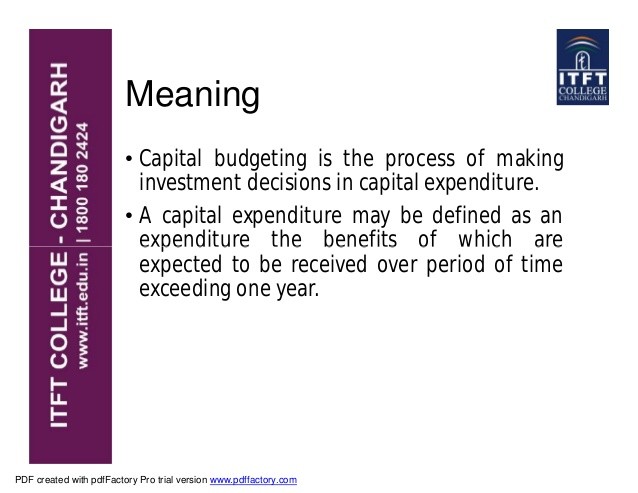An Introduction To Capital Budgeting_2
Post on: 9 Апрель, 2015 No Comment

Readings: Chapter 10
At the end of this unit students should be able to:
Define capital budgeting and explain why it is important.
List the steps involved in evaluating a capital budgeting project.
Classify capital budgeting project proposals
Calculate payback period, discounted payback period, Net Present Value (NPV), and Internal Rate of Return (IRR) for a given project and evaluate each method.
Explain the rationale behind the NPV and IRR methods, their reinvestment rate assumptions, and which method is better when evaluating independent versus mutually exclusive projects.
Define and construct NPV profiles
Briefly explain the problem of multiple IRRs and when this situation could occur.
Calculate the Modified Internal Rate of Return (MIRR) for a given project and evaluate this method.
Identify and explain the purposes of the post-audit in the capital budgeting process.
Capital budgeting is also known as ‘capital investment appraisal’. It is the process of using the company’s resources to acquire long-term assets, which allows the company to carry on its operations. These decisions are different from current expenditure, which is concerned with short-term assets. They are also different from portfolio investments (which is the allocation of excess cash to acquire financial assets). However, the portfolio investment process is similar to the capital budgeting process.
1. Capital budgeting decisions are important since they normally involve all ranks of management
2. Once the decision is taken it normally locks the company into a fixed path of production for some time
3. It also involves large sums of money, which can be recovered only over several years.
The main objective of capital budgeting is the selection and implementation of those projects, which increases the value of the firm, that is, increases shareholders’ wealth.
There is a four-step process to capital budgeting:
1. Identify the opportunities available to the company
2. Obtain and collate all pertinent information

3. Apply one or more of the decision rules and select the best alternative or alternatives
4. Complete a post-audit, That is, revisit the information gathering and the decision making process with the aim of improving them for future use.
Expansion vs Replacement Projects
There are basically two broad classifications of projects
1. The expansion-type project — the company acquires resource machinery in order to produce new products or to enter into new markets.
2. The replacement type project. This is aimed at replacing obsolete machinery in order to maintain current operations
Mutually Exclusive vs Independent Projects
Mutually exclusive projects are those where the decision to accept one precludes the acceptance of any other. Normally, mutually exclusive projects are aimed at achieving the same end but only one can be selected. Independent projects on the other hand are those where the acceptance of one does not affect the decision to accept the other, in other words, all can be accepted.
Accounting Income vs Cash flows
Net Income is not a good decision variable in Finance. The reason for this is that Net Income is the figment of a creative accountant’s mind, and therefore very subjective. The variable of importance is called cash flows, which is concerned with the cash flowing in and out of the company.
Capital Rationing
Capital Rationing is the process of deliberately limiting the funds available for capital investment. By so doing the firm with a number of acceptable projects may have to forego some, as available funding does not allow investing in all the good projects. The main reason for this is the reluctance of the company to use external sources of funding. Capital rationing therefore does not maximize the value of the company. Nevertheless, the Profitability Index (see below) is the criteria which is often used to rank projects when Capital Rationing exists. The Profitability Index is not a full proof method as there are occasions when its use does not accurately reflects the proper ranking.
Project Selection Methods
There are two basic categories:














